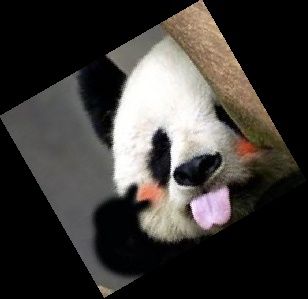OpenCV图像旋转
图像旋转是指图像按照某个位置转动一定角度的过程,旋转中图像仍保持这原始尺寸。图像旋转后图像的水平对称轴、垂直对称轴及中心坐标原点都可能会发生变换,因此需要对图像旋转中的坐标进行相应转换。
如下图:
假设图像逆时针旋转 θ θ ,则根据坐标转换可得旋转转换为:
{x′=rcos(α−θ)y′=rsin(α−θ)(1) (1) { x ′ = r cos ( α − θ ) y ′ = r sin ( α − θ )
而
r=x2+y2−−−−−−√,sinα=yx2+y2−−−−−−√,cosα=xx2+y2−−−−−−√ r = x 2 + y 2 , sin α = y x 2 + y 2 , cos α = x x 2 + y 2
带入(1)可得:
{x′=xcosθ+ysinθy′=−xsinθ+ycosθ { x ′ = x cos θ + y sin θ y ′ = − x sin θ + y cos θ
即如下:
[x′y′1] =[xy1] ⎡⎣⎢cosθsinθ0−sinθcosθ0001⎤⎦⎥(2) (2) [ x ′ y ′ 1 ] = [ x y 1 ] [ cos θ − sin θ 0 sin θ cos θ 0 0 0 1 ]
而旋转后的图片的灰度值等于原图中相应位置的灰度值如下:
f(x′,y′)=f(x,y) f ( x ′ , y ′ ) = f ( x , y )
同时我们要修正原点的位置,因为图像中的坐标原点在图像的左上角,经过旋转后图像的大小会有所变化,原点也需要修正。实现代码如下:
#include "opencv2/core/core.hpp"
#include "opencv2/imgproc/imgproc.hpp"
#include "opencv2/highgui/highgui.hpp"
#include (j, i) = matSrc.at(y, x);
}
}
}
return matRet;
} 测试代码:
int main()
{
std::string strPath = "D:\\MyDocuments\\My Pictures\\OpenCV\\";
Mat matSrc = imread(strPath + "panda.jpg");
if (matSrc.empty())
return 1;
float angle = 30;
Mat matRet = imgRotate(matSrc, angle, true);
imshow("src", matSrc);
imshow("rotate", matRet);
// 保存图像
imwrite(strPath + "rotate_panda.jpg", matRet);
waitKey();
return 0;
}

